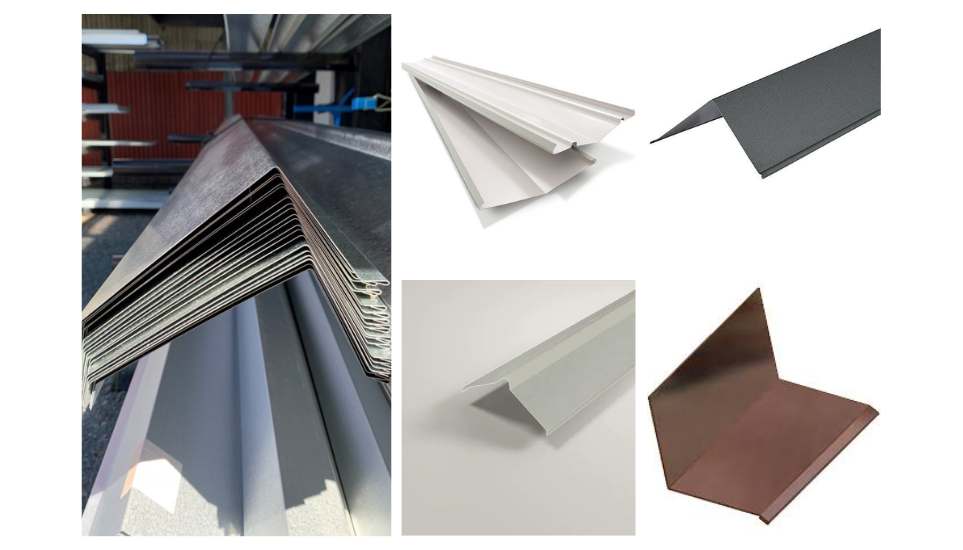In the world of construction and architecture, there are many elements that form the backbone of a sturdy, efficient, and visually appealing structure. One such unsung hero is metal flashing. These thin pieces of metal, often unnoticeably integrated into the edges and joints of roofs and walls, play a crucial role in preserving the integrity of a building.
Flashing serves as a protective barrier, warding off water, dust, and unwanted pests, and safeguarding the structure from corrosion and damage. With a variety of types tailored to different applications and needs, metal flashing is a key component in construction projects.
In this post, we delve into the pivotal role of metal flashing, shedding light on its importance and functionality in construction. Join us as we unravel the significance of this often overlooked, yet indispensable element in our buildings. Stay tuned!
Types of Metal Flashings:

Barge Capping
Barge capping is a type of flashing that runs along the edges of a roof where it meets a wall or gable. It provides an aesthetically pleasing finish and prevents water from running down the wall, protecting it from potential water damage. This type of flashing comes in different shapes and profiles, including corrugated, trimdek, or klip lok. The choice of profile depends on the roof design and materials used.
Roll Top Ridge Capping
Roll top ridge capping is another type of flashing that provides coverage for the ridge or peak of a roof where two slopes meet. It has a curved or rolled edge that adds strength and enhances the visual appearance of the roof. Materials commonly used include colorbond, zincalume, or aluminium.
Right Angle Flashing
Right angle flashing is used to create a 90-degree angle between two surfaces, typically found at the junction of a roof and wall. It serves as an essential element in various applications such as skylights, windows, doors, or vents. This type of flashing comes in different sizes and colors, depending on the specific requirements.
Valley Gutter
Valley gutter is a type of flashing that is used to form a shallow gutter between two internal slopes of a roof. Its purpose is to collect and drain rainwater, preventing it from pooling and causing any potential damage. Valley gutter comes with various features such as upstands, squashfolds, or segments which improve its functionality and appearance.
Apron Flashing
Apron flashing is used to cover the junction between a roof surface and a vertical surface, such as a wall, chimney, or dormer. It acts as a barrier against water seepage and protects the structure from potential leaks or damage. This type of flashing comes in different lengths and widths, depending on the specific roof design and pitch.
Corner Capping
Corner capping is used to cover the external corners of walls or roofs, providing a smooth and uniform finish. It also serves as protection against weathering and impact on these vulnerable areas. The angles and dimensions of corner capping can vary depending on the building’s design and style.
Box Gutter
Box gutter is a type of flashing that is used to form a square or rectangular gutter within the boundaries of a roof. It is typically found between a roof surface and a parapet wall, or between two roof surfaces. Box gutter comes with different edges such as infold, outfold, splashback, or squashfold, each catering to specific applications.
Keep them in top condition, and they will continue to serve you well for many years to come. Thank you for reading! If you want to know more about metal flashings, don’t hesitate to reach out.
Conclusion:
The world of construction and architecture is filled with intricate details, each playing a unique role in creating safe, efficient, and visually appealing structures. Metal flashings, while often overlooked, serve as the silent guardians of our buildings, protecting them from various elements and extending their lifespan. Understanding these different types of metal flashings, their unique features, and their specific applications helps us appreciate the complexity and ingenuity behind our everyday structures. It’s a testament to the brilliance of architectural design and a reminder of the importance of every piece, no matter how small or inconspicuous, in the grand scheme of construction. Arm yourself with this knowledge, and you’ll be well on your way to maintaining the integrity and value of your property.